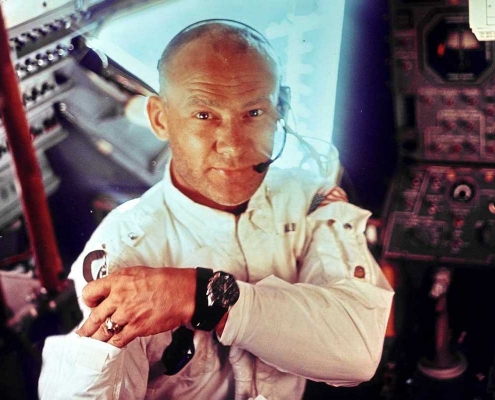The Omega Speedmaster represents both a timeless design and a legendary history, one that is deeply intertwined with the era of space exploration. The Speedmaster was the first watch to be worn on the surface of the moon, and it is rumoured that it will be the first watch to be worn on Mars as soon as a manned mission can be safely launched. Affectionately known as the 'Speedy', the Speedmaster is loved by collectors and owners alike and is as sought-after today as when it was first introduced.
A Speedmaster is not automatic, but must be wound by hand. The reason for this is that an automatic watch relies on the movement of weights, making it useless in low to zero gravity environments.
Omega was known for its pilot's watches and supplied the British Flying Corps, the forerunner of the Royal Air Force, from 1917 onwards. Other armed forces also chose Omega, including the British forces during the Second World War. A traditional pocket watch would have been easily lost, damaged or unusable in demanding conditions, and so a wrist-mounted timepiece was commonly used in the military. The 27 CHRO C12 calibre was introduced in 1942 and would pave the way for the Speedmaster. This calibre is a magnificent example of its kind, and has been used as the basic movement not only by Omega, but also by Breguet, Patek Philippe and Vacheron Constantin.
The Speedmaster was born in 1957 when it was introduced as a race and sports chronograph, a watch with a stopwatch function that could be easily read. Swiss designer Claude Baillod designed the first model, known as CK 2915 or the "Broad Arrow", to be both robust and highly readable. The watch had an anti-shock and anti-magnetic movement with a triple-sealed steel case that was water-resistant to 60 metres (200 feet). Baillod placed the tachymetric scale (which allows a user to measure speed based on the time travelled over a fixed distance, thus converting time into speed) on the bezel (the outer edge of the watch) rather than on the dial, and used highly contrasting hour and minute hands.
At that time, chronographs represented a very small part of the market. Chronographs were seen as an instrument aimed at professionals rather than the ordinary wearer. Omega's first marketing campaign for the Speedmaster targeted "men who calculate time in seconds", whom they called "scientists, engineers, TV and film directors, athletes and their coaches". Within a few years Omega had released three technical watches: the Seamaster in 1953, a diver's watch that had to compete with similar models from Blancpain and Rolex; the Railmaster in 1957, another watch aimed at professionals in the transport industry; and the Speedmaster. All three are still in production, although the Speedmaster is the most coveted of the series.
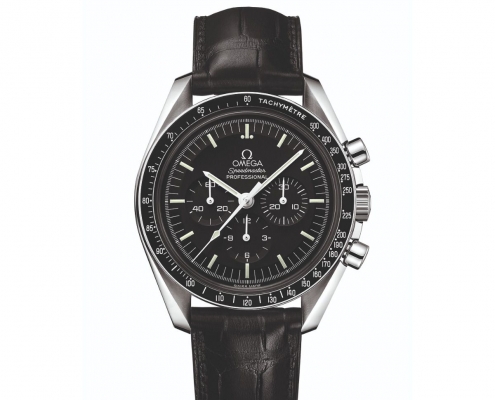
In the same year, 1962, NASA began officially testing watches that could withstand the rigours of space travel. An apocryphal story tells that two NASA officials were sent to a Houston jewellery shop to choose a pair to experiment with. Five watches were bought and tested, with the Speedmaster beating the competition. According to rumours, these competitors were Breitling, Rolex and Longines. According to another story, a tender was sent to several watch manufacturers, only a few of which responded.
Testing of NASA watches officially began in 1965, and they were subjected to a series of tests. Watches were subjected to eleven exams, each of which they had to pass eleven times. They included high and low temperatures from 93°C to -18°C, the same high and low temperatures but in a pressure chamber, humidity of at least 95%, an environment with pure oxygen without deterioration, shock tests in six different directions, rapid acceleration, decompression in a high temperature vacuum, intense vibration and high frequency acoustic noise.
The Speedmaster gained 21 minutes in the decompression test, lost 15 minutes in the acceleration test and the luminous paint on the dial evaporated, but the watch functioned properly and it was the only watch that survived.
NASA kept their approval of the Speedmaster a secret. The Omega factory only found out about the extraordinary success of their product when they saw a press photo of astronaut Edward White on a spacewalk in 1965. Omega decided to add the word "Professional" to the model, making it the Omega Speedmaster Professional.
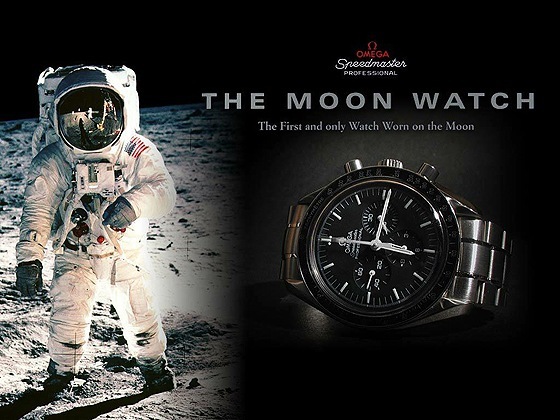
The Speedmaster is often referred to as 'The Moonwatch', as it was the timepiece worn during the Apollo 11 landing. However, although two men walked on the moon, only one Speedmaster from that journey landed on the moon. Neil Armstrong did not wear his watch during that historic moonwalk, as he had left it in the shuttle with Michael Collins to serve as a spare for a faulty device. It was Edwin "Buzz" Aldrin who took the Speedmaster to the moon, tied over the wrist of his spacesuit with a wide strip of Velcro. Unfortunately, this historic watch was lost on its way to the Smithsonian and never found again.
Although the Speedmaster strapped to Buzz Aldrin's wrist on July 24, 1969 is the watch that takes the prize as THE first watch on the moon, it is not the first time the Omega Speedmaster has reached space. That honour belongs to a watch that astronaut Wally Schirra bought with his own money and wore during the Mercury-Atlas 8 mission, during which he flew into orbit six times in the Sigma 7 spacecraft. The reference that Schirra wore was the CK2998, produced in eight variations from 1959 to 1963, what is most important to note about this reference is the change to a black aluminium bezel and narrower 'Alpha' dial.
In 1978, NASA decided to reconsider the selection of watches for space missions and opened the competition to other watchmakers. Just like the first time, the Omega Speedmaster beat out the competition and was again certified as the official watch of the space programme.
The Omega Speedmaster was indispensable during the troubled Apollo 13 mission when astronauts had to switch off their shuttle's electronic systems. Commander Jim Lovell had to rely on his watch to time the return rockets to a fraction of a second. Another test for the Speedmaster.
Five years after this certification, Buzz Aldrin stepped out of the Apollo 11 lunar module with a Speedmaster bearing reference 105,012, thus confirming Speedmaster's status as the first watch on the moon. Shortly after Apollo 11 landed back on Earth, Omega celebrated the achievement by issuing the first limited edition Speedmaster, a solid gold model, reference BA145.022-69, the first 28 of which were presented to President Nixon, Vice President Agnew and all the Astronauts in service at the time. Later Astronauts also received this model, and some were produced until 1973 - a total of 1014 were made. It is this model that Omega chose to re-create to celebrate the 50th anniversary of the moon landing with the 2019 Speedmaster Apollo XI 50th Anniversary edition, introducing the Moonshine Gold.
Not only do American astronauts rely on it, the Russian space programme also wears Omega Speedmasters. The iconic watch was involved in the historic docking of the Apollo and Soyuz spacecraft in 1975, at the height of the Cold War: Omega donated Speedmasters to the Russian cosmonauts so they would be on time for their meeting, which they wore during the mission. Fourteen years later, it was discovered that the Russians were so impressed with the watches that they too had introduced them as standard equipment for all astronauts in space.
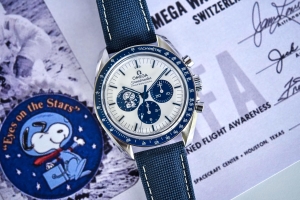
The story of the Speedmaster in space does not end with Apollo 11, as the watch remains a functional piece of equipment to this day. But one famous incident deserves special mention: the role of the Speedmaster in the dramatic Apollo 13 mission. After an explosion on board 200,000 miles from Earth, Apollo 13 was stranded in space after hasty repairs were made. A Speedmaster was used to time the crucial 14-second rocket burn that ensured a safe return to Earth's atmosphere. This achievement earned the Speedmaster and Omgea a 'Snoopy' award on 5 October 1970, in recognition of helping the astronauts return safely.
Charles Schulz's cartoon dog was a kind of unofficial mascot for the Apollo missions, awarded for outstanding contributions from staff and contractors. For this reason, Omega has produced two 'Snoopy' Speedmasters, one in 2003 and one more recently in 2015. The new Omega Speedmaster Silver Snoopy Award commemorates the 50th anniversary of that award.
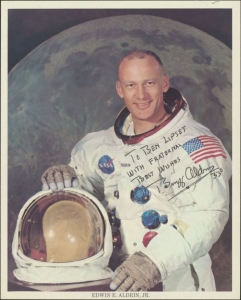
The historic Apollo 11 voyage went down in world history, and will always be known as one of the most important space missions of all time.
The moonwalk was spectacularly important for NASA, science, and society as a whole.
In addition, the first trip to the moon was also important for Freemasonry. Why?
Because the Apollo 11 mission to the moon was piloted by Edwin 'Buzz' Aldrin, an active Mason.
You may know him as one of the first men on the moon, but we know him as the first Mason on the moon.
Brother Edwin Eugene (Buzz) Aldrin, Jr. was an active Mason and is a member of Clear Lake Lodge No. 1417, AF&AM in Seabrook, Texas.
He was born on January 20, 1930 in Glen Ridge, New Jersey and attended the United States Military Academy at West Point, graduating third in his class in 1951. Brother Aldrin later earned a doctorate in astronautics from M.I.T. in 1963. He served in the Korean War and shot down two enemy fighters during his tour.
Brother Aldrin was initiated into Freemasonry at Oak Park Lodge No. 864 in Alabama and raised at Lawrence N. Greenleaf Lodge, No. 169 in Colorado. He is also a member of the York Rite and the Arabia Shrine Temple in Houston.
At the height of the Apollo 11 mission to the moon, the Grand Master of Texas approved Brother Aldrin's request to open a representation of the Grand Lodge of Texas on the moon and thus establish Masonic territorial jurisdiction there.
He also asked Buzz to take a special deputation with him on his trip. Aldrin signed this deputation and confirmed that it was indeed carried to the moon.
Aldrin also carried a handmade silk Masonic flag on his space journey, embroidered with the words, "Supreme Council, 33°, Southern Jurisdiction, USA."
After his mission on 16 September 1969, Brother Aldrin visited the Temple House in Washington, DC, and presented the flag to Grand Commander Luther Smith.
The flag is now in the archives of the House of the Temple.
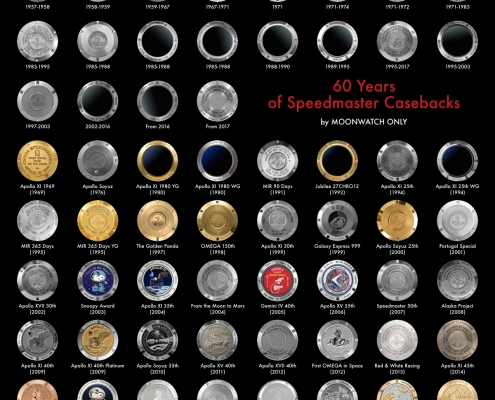
Between 1970 and the introduction of Co-Axial movements to the collection in 2005, the Speedmaster saw numerous other interesting additions and oddities, from the electronic F300-powered Speedsonic, to a quartz digital Speedmaster, and finally to the X-33 from 1998, Omega has never been afraid to implement new technology into its iconic chronograph.
Then there are watches like the colourful Speedmaster Racing with yellow, red and blue dials launched by Michael Schumacher in 1996, which used the popular automatic Speedmaster 'Reduced' as its basis. The 'Reduced', better known as the Speedmaster Automatic, was a smaller, automatic sibling of the Moonwatch, first introduced in 1988, and discontinued in 2009 or so. With its smaller 38.5 mm case, convenient automatic movement and typically lower price, the Reduced is a fantastic entry into the world of the Speedmaster.
The Speedmaster is now just over 60 years old, and frankly, it looks better than ever.
In addition to the classic Moonwatch, which is fundamentally unchanged from the watch that accompanied the Apollo 11 astronauts,
the Speedy is joined by the heritage-inspired Speedmaster '57, the sportier Racing Line, and several digital options.
Then there are Co-Axial models in different shades of ceramic, with moon phases, jewel-encrusted cases, blue dials, panda dials, and all the other kinds of dials you could wish for.
There are currently 44 different Speedmasters in Omega's catalogue, all of which are the legacy of this legendary chronograph.
Thierry Stravers is co-owner of Masonic Store.
He likes to combine his passion for style and elegance with his Masonic activities.
Thierry is the owner of Trenicaa marketing agency and is a board member of Loge Enlightenment No.313 O: Hoofddorp.

